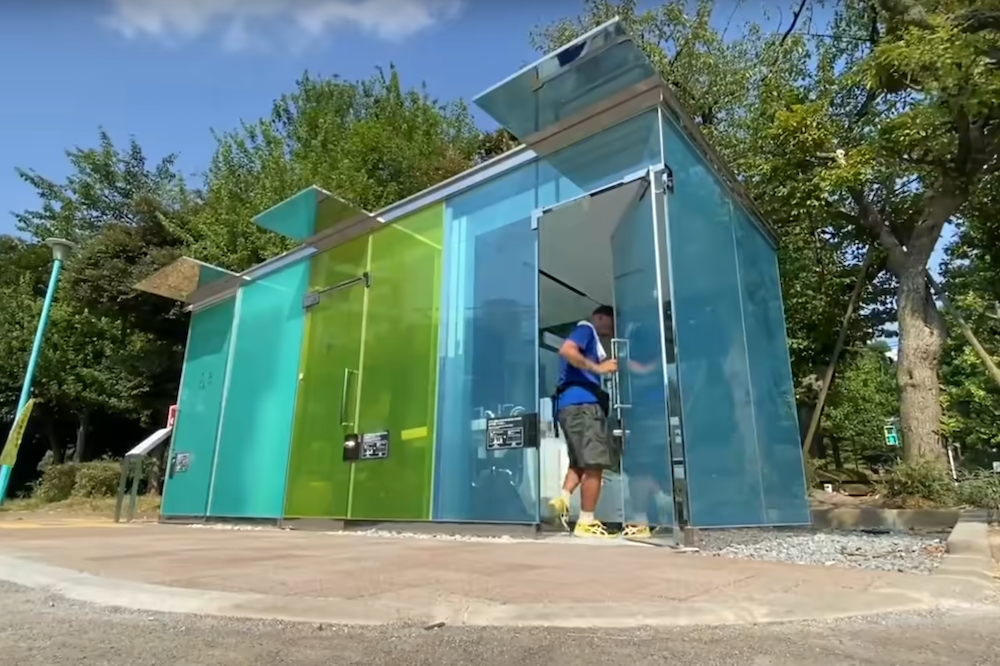
[Image above] The glass-walled restrooms above, located in two parks in Japan, are part of a project to dispel perceptions that public toilets are dark, dirty, and smelly. Credit: South China Morning Post, YouTube
For years the United States was considered the uncontested leader in science and engineering. But lately, the country’s position is slipping.
“Increasingly, the United States is seen globally as an important leader rather than the uncontested leader,” the State of U.S. Science and Engineering 2020 report says.
The report, compiled and published every two years by the National Science Board and the National Science Foundation, explains that despite a continued rise in absolute science and technology activity levels in the U.S., the relative share of this activity globally remains unchanged or has shrunk.
In other words, “The rapid development of science and engineering capabilities in other countries causes U.S. spending and efforts in that subject to appear stale, despite its growth,” a CNN article on the report explains.
Of course, in many areas the U.S. continues to be at the forefront of invention and innovation. But in other areas, evidence the U.S. is falling behind is obvious.
Such as toilets.
Toilets are likely one of the last technologies people in the U.S. would imagine as an example of technological innovation. But take a trip to Japan, and the difference between toilets in the two countries is startling.
“Japanese toilets are marvels of technological innovation,” an NPR article explains. “They have integrated bidets, which squirt water to clean your private parts. They have dryers and heated seats. They use water efficiently, clean themselves and deodorize the air, so bathrooms actually smell good. They have white noise machines, so you can fill your stall with the sound of rain for relaxation and privacy. Some even have built-in night lights and music players. It’s all customizable and controlled by electronic buttons on a panel next to your seat.”
The high-tech toilet revolution in Japan started in 1980, when toilet manufacturer TOTO released the Washlet, a first-of-its-kind electric toilet seat with an integrated bidet. Since then, TOTO has continued to innovate the classic toilet design and today is well-known globally for its high-tech bathroom experience.

Innovating the bathroom experience in Japan is not just limited to personal and private settings. Cleanliness and hygiene are big parts of Japanese culture, which is why a new project to revolutionize the public restroom experience comes as no surprise.
The Tokyo Toilet project
The Tokyo Toilet project is a new initiative by the Nippon Foundation, a Tokyo-based private, nonprofit grant-making organization whose mission is social innovation.
“Through this innovation we aim to achieve a society where all people support one another, reducing the burdens and challenges they face together,” the Nippon Foundation website explains.
In regard to the new toilet project, Nippon Foundation says the use of public toilets in Japan is limited because of stereotypes that they are dark, dirty, smelly, and scary.
“To dispel these misconceptions regarding public toilets, The Nippon Foundation has decided to renovate 17 public toilets located in Shibuya, Tokyo, in cooperation with the Shibuya City government,” a press release announcing the project explains.
To create the toilets, the Nippon Foundation partnered with 16 architects to give each location a unique design. And these architects include some of the brightest names in Japanese architecture, such as Shigeru Ban, Toyo Ito, Tadao Ando, and Fumihiko Maki, each previous winners of the prestigious Pritzker Architecture Prize.
Currently five of the 17 locations are open to the public. And of these locations, two in particular have gained a lot of interest on social media since their debut.
Open to the public: Glass-walled restrooms
The bathrooms in Yoyogi Fukamachi Mini Park and Haru-no-Ogawa Community Park were both designed by the firm of Japanese architect Shigeru Ban. Ban is known for his innovative work with paper, but these two facilities are gaining attention for a different reason—the glass walls.
“There are two things we worry about when entering a public restroom, especially those located at a park. The first is cleanliness, and the second is whether anyone is inside,” Ban’s webpage on the project says.
To address these concerns, Ban designed restrooms with transparent glass walls that turn opaque once the door is locked.
“This allows users to check the cleanliness and whether anyone is using the toilet from the outside,” the webpage continues.
An article in The New York Times on the facilities explains how the glass works.
“When occupied and locked properly, the tinted glass toilet stalls become frosted and opaque. When the door is unlocked, an electric current realigns the crystals in the glass to allow more light to pass through, creating a transparent effect,” the article says.
Witness the glass for yourself in the video below.
This project is not the first time glass-walled restrooms appeared in public. Designer Olivier Rambert previously unveiled similar glass bathrooms in Lausanne, Switzerland. However, those facilities included a controversial safety feature that automatically opened the doors and turned the glass transparent if sensors detected no motion for 10 minutes, such as in the case of a medical emergency in which the occupant fell unconscious.
If the idea of using a glass-walled restroom does not sound appealing, don’t worry—the other facilities included in the Tokyo Toilet project feature completely different designs. You can take a look at the other three facilities currently open to the public here, here, and here.
